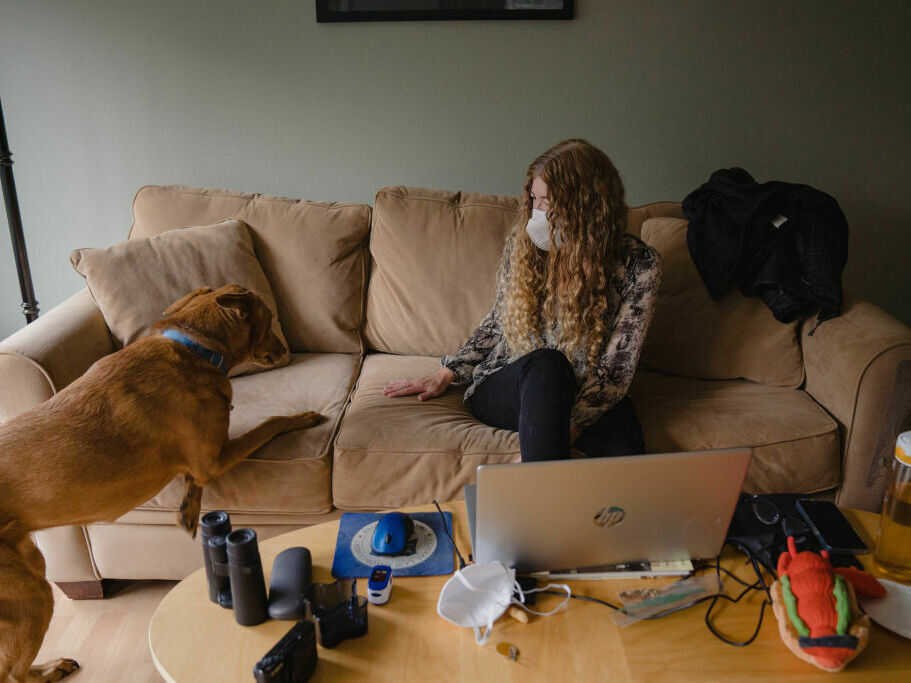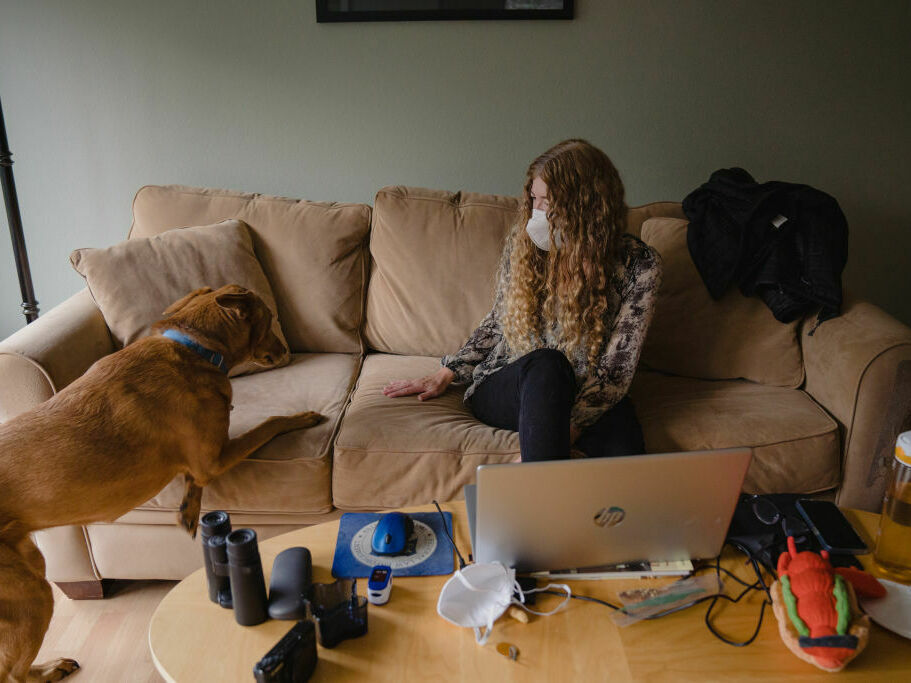[ad_1]

Prolonged COVID — lingering signs that can stick to a COVID analysis — plagues thousands and thousands of People. It could be fewer probably following a second bout of COVID than after a first. For individuals living with it, it can be debilitating. Judy Schafer, 58, satisfied with a group of other gals with extended COVID via Zoom, at her dwelling in Seattle, Clean., in January.
Jovelle Tamayo/The Washington Post by way of Getty Photographs
conceal caption
toggle caption
Jovelle Tamayo/The Washington Submit by using Getty Illustrations or photos

Extended COVID — lingering symptoms that can comply with a COVID analysis — plagues hundreds of thousands of Americans. It might be a lot less very likely soon after a next bout of COVID than after a very first. For individuals dwelling with it, it can be debilitating. Judy Schafer, 58, fulfilled with a group of other women of all ages with long COVID by means of Zoom, at her property in Seattle, Clean., in January.
Jovelle Tamayo/The Washington Article by way of Getty Pictures
If you have gotten COVID much more than after, as many people today have, you may be pondering if your chance for suffering the lingering symptoms of lengthy COVID is the exact with each and every new infection.
The reply seems to be no. The probabilities of extended COVID — a suite of signs which include exhaustion and shortness of breath — falls sharply between the initially and next infections, according to recent exploration.
“It does appear that the threat is drastically lower the 2nd time close to than the initially time about for establishing very long COVID,” suggests Daniel Ayoubkhani, a statistician at the Business for Nationwide Statistics in the United Kingdom, who’s been studying lengthy COVID in that country.
But the possibility does not tumble to zero, according to the hottest results of an ongoing survey of much more than 500,000 persons in the U.K. by way of March 5.
“The chance of very long COVID is appreciably lower, … but it is really nevertheless non-negligible. It can be not unattainable to acquire very long COVID the second time if you didn’t acquire it the to start with time. I assume which is the important takeaway from our examine,” Ayoubkhani suggests.
The study tracked lengthy COVID signs like tiredness, muscle mass aches, shortness of breath and concentration difficulties. Exhaustion and difficulties concentrating were the most common.
Among the grownups in the survey, 4% claimed lengthy COVID signs persisting at least four weeks soon after their initial an infection, the survey located. In distinction, just 2.4% of all those who hadn’t designed lingering overall health difficulties right after their very first infection reported ongoing indicators just after their 2nd circumstance.
“Which is a considerable reduction in the odds,” he says.
The review didn’t analyze why the possibility for very long COVID would be decreased from a second infection than a initially. But Ayoubkhani states there could be numerous causes.
For case in point, the immunity folks have built up from previous infections may lessen the possibility of producing lengthy COVID from the following one particular. “We do not know that from our facts, but that’s a hypothesis,” he says.
Another chance is that the review excluded those people who experienced gotten lengthy COVID from their 1st an infection, so those who did not get it from their 1st infection may perhaps be innately significantly less prone to prolonged COVID for some rationale.
“It could have a thing to do with someone’s predisposition,” he states.
The study also failed to examine whether a second infection worsens signs in people today who by now have prolonged COVID.
Even however the examine was performed in the U.K., there is no cause to believe that the outcomes wouldn’t utilize to the U.S., he says.
In actuality, the findings are dependable with an previously analyze that made equivalent results by analyzing knowledge from hundreds of hundreds of individuals addressed by the U.S. Veterans Administration.
That study, which was revealed in November, identified that the chance of nonetheless encountering health and fitness problems a calendar year immediately after finding COVID fell from about 10% from a first an infection to about 6% from a 2nd infection.
“Undeniably, we are observing incredibly, extremely clearly that for the second an infection the hazard is decrease than the initial infection,” claims Dr. Ziyad Al-Aly, an epidemiologist at Washington College in St. Louis who led that analyze.
Al-Aly agrees that may possibly be owing in aspect to immunity from the to start with infection. Yet another variable is that afterwards strains of the virus appear to result in milder ailment, which may possibly make them considerably less likely to guide to prolonged-COVID.
“When people today got re-infected they frequently obtained re-infected with omicron, which is certainly milder,” he explained, talking about the final results of his study.
Yet another achievable affect may be enhanced solutions, which lessened the severity of COVID, he claims.
Neither examine examined the hazard of extensive COVID immediately after a third or fourth infection, but Al-Aly hopes that the chance would carry on to decrease with each individual subsequent infection.
“All these things are pointing in the proper route that helps make me optimistic that at some position in time re-infection may possibly add trivial hazards or non-consequential challenges,” he suggests.
“That’s our hope. We you should not have details. But which is our hope,” he suggests.
But Al-Aly notes that since so lots of persons are even now catching the virus, the in general amount who are struggling from lingering wellbeing complications continues to improve even if there is a reduced hazard from second bacterial infections.
“I kind of liken it to Russian Roulette,” Al-Aly claims. “The odds at the person stage of finding lengthy COVID immediately after a next an infection compared to the 1st is reduce for any specific particular person.”
But he adds, “that hazard is not zero,” and that signifies at a inhabitants degree, we continue to see a growing selection of situations of long COVID in the neighborhood — and a developing stress on caregivers and culture.
Edited by Carmel Wroth.
[ad_2]
Supply backlink



